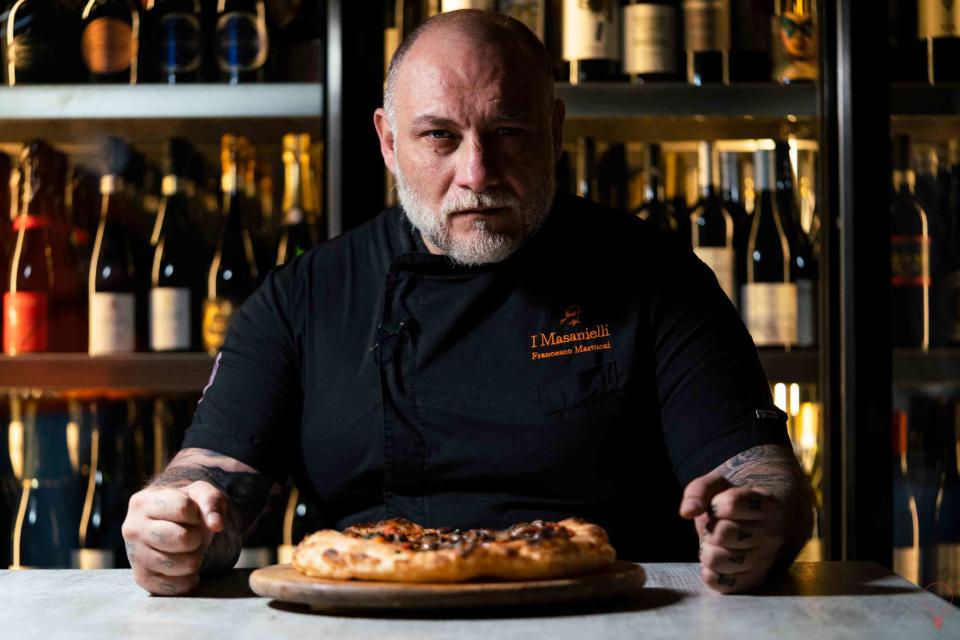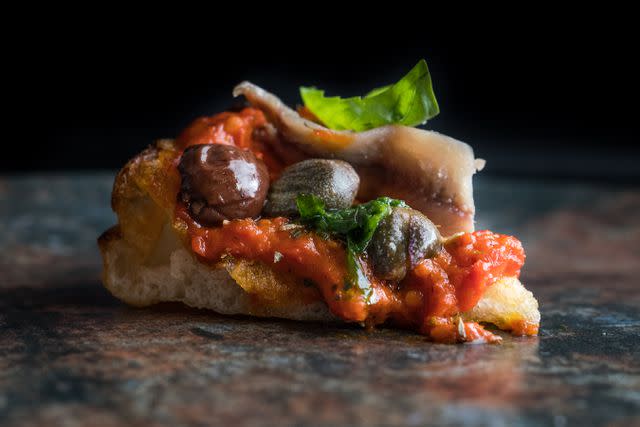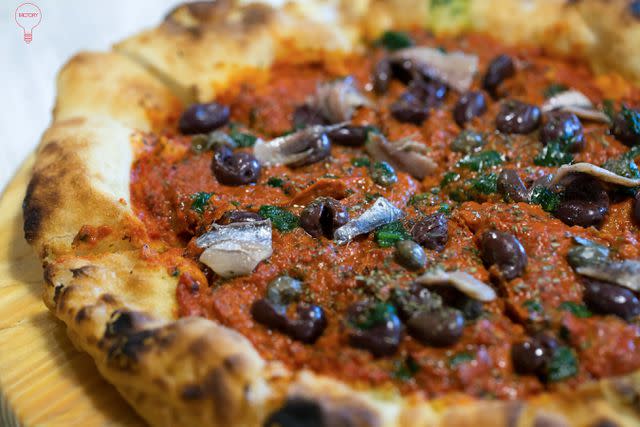What It’s Like to Eat at the World’s Best Pizzeria
Be prepared to reserve your table two months in advance to dine at Pizzeria I Masanielli, located in a sleepy Italian city known for its buffalo mozzarella.

Courtesy
Though you might expect to find the world’s best pizzeria in Naples, as it's the birthplace of the popular dish, the place ranked the best by the 50 Top Pizza guide is actually in a small city called Caserta.
Located about 40 minutes north of Naples on Italy’s A1 highway, the city’s main claim to fame is the Reggia di Caserta, the royal palace built in the mid-1700s by Bourbon King Charles III to rival Versailles. Caserta is also known for mozzarella di bufala, which is considered far superior to the average cow’s milk mozzarella (in Italy known as fior di latte). And where there’s high-quality mozzarella di bufala, it’s only logical that there would be high-quality pizza.
Since moving to Rome, I’ve become a bit of a pizza fiend — and my husband, Marco, is an even bigger one. So when he asked me to see if I could get us a reservation at Pizzeria I Masanielli — ranked the world’s best pizzeria by the illustrious judges at 50 Top Pizza — I immediately logged onto the restaurant’s online reservation system and booked us a table two months in advance.
:One of the Most Famous Pizza Places in Italy Just Opened in New York City
Our reservation was at 8 p.m. on a recent Saturday night, and we decided to make it into a mini weekend getaway. We drove down to Caserta that morning so we could visit the Reggia, with its royal apartments and extensive gardens. When we checked into our B&B that afternoon, the owner offered to drop us off in the Medieval part of the city, which we didn’t even know existed. But like many Italian cities, Caserta is divided into the older hilltop citadel and the newer city below.
While Medieval Caserta retains some of the charm you find in historic towns all over Italy, the newer part of town, where I Masanielli is located, is a bit more industrial. The pizzeria is in a commercial building adjoined by a store for baby clothes and gear. When we arrived at 7:45 p.m., there was a crowd of at least 30 people waiting to get in. “It feels like trying to get into the discotheque at midnight,” Marco said, as he led me through the crowd to check in with the hostess.

Courtesy
On I Masanielli’s website, slots for tables are available every hour on the hour, but the email confirmation you receive when you book a table warns that you might have to wait up to 30 minutes even if you have a reservation. We were seated at 8 p.m. on the dot and began by ordering some beer and fritti, fried appetizers typically served at Italian pizzerias. In Rome, we usually get supplì, but in Naples and the surrounding area it’s more common to find frittatine (pasta that’s been breaded and fried) and crocchette (potato croquettes). We ordered these and one of the arancine, which in this case was a smaller version of the typical Sicilian fried rice ball.
:If You Eat One Cheese in Tuscany, Let It Be This
Francesco Martucci, I Masanielli’s owner and master pizzaiolo, considers himself a bit of a renegade, but he’s part of a growing movement of chefs transforming this humble dish into a gourmet offering.
For Martucci — and any pizzaiolo worth their salt — using the best quality ingredients is non-negotiable. At I Masanielli, that means using San Marzano tomatoes, fresh mozzarella di bufala, capers from Salina, anchovies from Trapani, and other Slow Food-certified ingredients. But Martucci is also upping the ante by using haute cuisine techniques and technology, like sous-vide machines, freeze dryers, dehydrators, flash freezers, and fermenters, in addition to pizza ovens that reach 600 degrees. A section of the menu is dedicated to pizzas cooked at three temperatures: steamed at 100 degrees, fried at 180 degrees, and baked at 400 degrees. When I catch up with Martucci later, he tells me that his work is all about the “incessant search for the perfect pizza.”
Marco and I ordered Le 5 Consistenze della Cipolla, a traditional wood-fired pizza topped with fior di latte cheese and onions in five consistencies (onion cream, fermented onion, crispy onion, burnt onion, and onion mayonnaise) and the Genovese Secondo Martucci, with stewed onions, fior di latte, pork cheek, and Roman ricotta conciato cheese, which was cooked at three temperatures. The former was a symphony of onions with a richness from their different textures and soft, pillowy dough, while the latter had a more substantial, almost crunchy dough. They were some of the best pizzas we’ve ever tasted.

Courtesy
The crowd that evening seemed to be predominantly Italian, but the secret is certainly out and people travel from all over the world to taste Martucci’s pizzas. Zoe Stella Shapiro, the Rome-based founder of the boutique tour company Stellavision Travel, even brings her small groups of travelers there.
“Several years ago, a friend and I drove from Rome to Caserta specifically to sample the world’s best pizza,” Shapiro says. “It absolutely lived up to the hype and when I needed a place to break up the journey from Puglia to Rome during the ‘Secret Southern Italy’ tour, it was the perfect place to stretch our legs, enjoy some culture at the Reggia di Caserta and have an incredibly memorable lunch. Our last meal as a group together takes our travelers to a spot most tourists bypass and comes with bragging rights that you’ve eaten at the number one pizzeria in the world, in the heart of the region that invented the world’s favorite food.”
I Masanielli makes, on average, a thousand pizzas per day and has a team of 42 staff, including 16 in the kitchen. “People come from all over the world," Martucci tells me, "which makes me proud because bringing people to get to know this region has a special taste."

